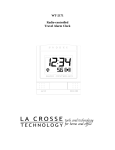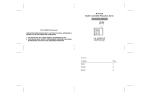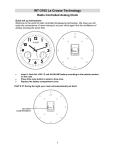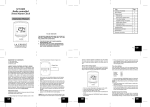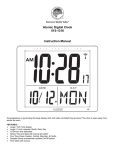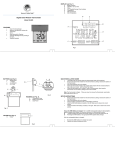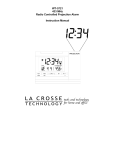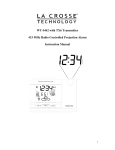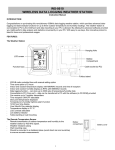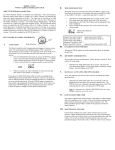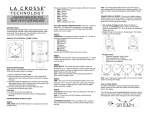Download WT-2165 Radio-controlled Travel Alarm Clock Instruction Manual
Transcript
Model: WT-2165 Radio-controlled Travel Alarm Clock Instruction Manual TABLE OF CONTENTS Topic Inventory of Contents Detailed Setup Guide Battery Installation About WWVB Programming Programming Sequence Time zone Daylight on/off Snooze setting Manual time setting Manual date setting Setting & Operating Alarms Operating Screens Traveling Troubleshooting Maintenance & care Warranty & contact information Page 2 3 4-6 6-10 6 7 7-8 8 8-9 9-10 10-12 12-13 14 15 16 17-20 1 INVENTORY OF CONTENTS 1. Radio-controlled travel alarm. 2. Instruction manual and warranty card. 2 DETAILED SETUP GUIDE I. BATTERY INSTALLATION A. The battery compartment is located on the back of the travel alarm. B. Remove the battery cover. C. Insert one AA battery (alkaline recommended) into the battery compartment making sure to observe the correct polarity. D. Replace the battery cover and do not press any buttons for 10 minutes while the travel alarm searches for the WWVB time signal. 3 II. PROGRAMMING A. SETTING THE TIME There are two methods by which the time and date can be set: 1) Automatically via WWVB reception, or 2) Manually. B. WWVB (Radio-Controlled Time) This method requires you to do nothing, except wait for the signal to be received, and to select a time zone. Reception usually takes approximately 6-10 minutes during optimal conditions. The best conditions for reception is at night, between midnight and 6:00 am—when there is less atmospheric interference. To keep your time as accurate as possible, the alarm clock conducts a WWVB search every night between these hours, and overrides any manually set time. The WWVB tower icon (appearing in the TIME LCD) will flash when a signalsearch is in progress and a signal is being received, and will remain steady when the 4 signal has been received. If the WWVB time has not been received after 10 minutes of battery installation, you may manually set the time or wait for the WWVB reception. About Radio-Controlled Time signal, WWVB: The NIST (National Institute of Standards and Technology—Time and Frequency Division) WWVB radio station is located in Ft. Collins, Colorado, and transmits the exact time and date signal continuously throughout the United States at 60 kHz. The signal can be received up to 2,000 miles away through the internal antenna in the alarm clock. However, due to the nature of the Earth’s Ionosphere, reception is very limited during daylight hours. The alarm clock will search for a signal every night when reception is best. The WWVB radio station derives its signal from the NIST Atomic clock in Boulder, Colorado. A team of atomic physicists is continually measuring every second, of every day, to an 5 accuracy of ten billionths of a second per day. These physicists have created an international standard, measuring a second as 9,192,631,770 vibrations of a Cesium133 atom in a vacuum. For more information please see the NIST website at www.boulder.nist.gov/timefreq/stations/wwvb.htm. C. PROGRAMMING (includes manual time setting) This section is designed to walk you through the entire set up procedure. If you only require setting one section please hold the “SET” button until the U.S. map flashes and then press and release the “SET” button until the section you wish to program begins flashing. The Programming Sequence is as follows: →Time Zone → DST On/OFF → Snooze Setting → Manual Time Setting (Hour → Minute) → Manual Date Setting (Year → Month → Date → Day) → 12/24-hour time format 6 **To end the programming mode at any time, simply press the SNOOZE button Time Zone Setting a) Press and hold the “SET” button until the US map and time zone begins to flash (“-5” is the default). The time zone is displayed according to “GMT”; please see the table for explanation. b) Press and release the “+” key to move the time zone West one hour until it reaches the your time zone. c) Press and release the “SET” key to set the time zone and move to the next programming step. -4: Atlantic, =-5: Eastern -6: Central, -7: Mountain -8: Pacific, -9: Alaska -10: Hawaii GMT: Greenwich Mean Time Eastern time zone shown Daylight Saving Time Setting d) “DST On” will flash. 7 e) Press and release the “+” key to toggle between the Daylight Saving Time ON or OFF (for places that do not follow Daylight Saving Time changes) f) Press and release the “SET” key. Snooze Duration Setting g) “Sno” will show at the bottom of the screen, and a number will flash at the top. This is the setting for the length of the alarm snooze. h) Press and release the “+” key to advance the length of time from 0 (no snooze) to 59 minutes. This sets the time the alarm is silenced after pressing the SNOOZE key while the alarm is sounding. i) Press and release the “SET” key. Manual Time Setting j) The hour will now flash. k) Press and release the “+” key to advance to the correct hour; be sure to note the correct am/pm setting (“PM” will show for hours between 12 noon and midnight). 8 l) Press and release the “SET” key. m) The minutes will now flash. n) Press and release the “+” key to advance the minutes. By holding the “+” key, the minutes will advance in five minute increments. o) Press and release the “SET” key. Manual Date Setting p) The year will now flash. q) Press and release the “+” key to advance to the correct year. r) Press and release the “SET” key. s) The month will now flash. t) Press and release the “+” key to advance to the correct month. u) Press and release the “SET” key. v) The date will now flash. w) Press and release the “+” key to advance to the correct day. x) Press and release the “SET” key. y) The day of the week will now flash (Sun, Mon, etc.). 9 z) Press and release the “+” key to advance to the correct day of the week. aa) Press and release the “SET” key. bb) “12” or “24” will now flash. cc) Press and release the “+” key to select either 12 –hour or 24-hour (military time). dd) Press and release the “SET” key to complete the programming. The programming is now complete. D. SETTING THE ALARMS La Crosse Technology’s travel alarm clock has two separate alarms that can be set. Each alarm has a distinctive sound and operates independently. a) Press and hold the “ALM1” (or “ALM2” key) key for two seconds to enter the setting mode. b) The alarm time will flash. c) Press and release the “HOUR” key to advance the hour of the alarm, and press 10 and release the “MIN” key to advance the minutes of the alarm. Note: If no button is pressed within fifteen seconds, the alarm will set and activate, and the clock will revert to the normal operating screen. The picture below shows both alarms activated. “Alarm 1” activated “Alarm 2” activated Activating the Alarms To activate/deactivate the alarm, press and release the “ALM1” or “ALM2” key once, depending on which alarm needs to be activated. Activating the SNOOZE function When the alarm is sounding, pressing the top of the unit gently backwards will 11 activate the snooze for the time that was selected in the programming mode. If the setting is “0”, the alarm will turn off for 24 hours. During the snooze period, the lower screen will show a countdown until the alarm will sound again. If the snooze is activated again during the original snooze period, the period will be reset. Once the period is finished, the alarm will sound again. Pressing any key other than the snooze will turn off the alarm for 24 hours. III. OPERATING SCREENS A. The exact time will always be displayed in the upper portion of the screen, and the US map will show when the time zone is set to the continental US (with the time zone selected showing in black). The lower portion of the screen has five different screens that can be selected. The default is “DAY, MONTH, DATE” as shown below. 12 B. Press and release the “MODE” key to select which screen to show. It will change in order as follows: 1. DAY MONTH DATE 2. MONTH DATE YEAR 3. SECONDS 4. ALARM 1 TIME 5. ALARM 2 TIME C. While in non-alarm mode, pressing the “SNOOZE” bar will show the “ALARM1” and “ALARM2” briefly in the lower section. 13 IV. TRAVELING A. When traveling, it will only be necessary to change to the appropriate time zone. Please note that the clock will only search for a signal when it is set between “GMT-4 and GMT-10.The alarm clock will set to any time zone from “GMT” to “GMT-12”. Outside this range, it will only be necessary to set the hour to the correct hour, leaving the time zone set to your local time zone. For example, if you are traveling to Hong Kong, you will need to manually set the hour to the local time. When the clock is back in the US, it will search for a signal and set to the proper time according to the time zone selected. 14 TROUBLESHOOTING NOTE: For problems not solved, please contact La Crosse Technology via e-mail or phone, or visit our website, www.lacrossetechnology.com Problem: The time and date will not set initially. Solution: It usually takes overnight before the clock can receive the signal due to the interference the sun has on the WWVB signal. Wait overnight for the signal. Solution: Computer monitors and televisions can cause interference with the signal reception. Please keep the clock at least six feet from electrical sources. Solution: In some areas of the US, in particular on the East and West coasts, the signal is sometimes weak. It may take up to 72 hours before a good signal is received. The reception can be helped by placing the clock in a window facing Colorado, with the back towards Colorado. 15 Solution: Be sure the time zone is set to a US time zone. MAINTENANCE AND CARE INSTRUCTIONS • • • • • Extreme temperatures, vibration, and shock should be avoided to prevent damage to the unit. Clean displays and units with a soft, damp cloth. Do not use solvents or scouring agents; they may mark the displays and casings. Do not submerge in water. Do not subject the units to unnecessary heat or cold by placing them in the oven or freezer. Opening the casings invalidates the warranty. Do not try to repair the unit. Contact La Crosse Technology repairs. SPECIFICATIONS Dimensions: 3.48” x 2.63” x 0.88” (L x W x H) (88 x 67 x 22 mm). Battery 1 AA (alkaline 16 Battery life recommended Approximately 1 year WARRANTY INFORMATION La Crosse Technology provides a 1-year warranty on this product. Contact La Crosse Technology immediately upon discovery of any defects covered by this warranty. Before sending the unit in for repairs, contact La Crosse Technology. The unit will be repaired or replaced with the same or similar model. This warranty does not cover any defects resulting from improper use, unauthorized repairs, faulty batteries, or the units’ inability to receive a signal due to any source of interference. LA CROSSE TECHNOLOGY WILL NOT ASSUME LIABILITY FOR INCIDENTAL, CONSEQUENTIAL, PUNITIVE, OR OTHER SIMILAR DAMAGES ASSOCIATED WITH THE OPERATION OR MALFUNCTION OF THIS UNIT. THIS PRODUCT IS NOT TO BE USED FOR MEDICAL PURPOSES OR FOR PUBLIC INFORMATION. THIS PRODUCT IS 17 NOT A TOY. REACH. KEEP OUT OF CHILDRENS’ This warranty gives you specific legal rights. You may also have other rights specific to your State. Some States do not allow the exclusion of consequential or incidental damages; therefore the above exclusion of limitation may not apply to you. For warranty work, information contact technical support, or La Crosse Technology, Ltd 2809 Losey Blvd. S. La Crosse, WI 54601 Phone: 608.782.1610 Fax: 608.796.1020 e-mail [email protected] (warranty work) [email protected] (information on other products) Website www.lacrossetechnology.com 18 FCC ID: OMO-01RX (receiver) THIS DEVICE COMPLIES WITH PART 15 OF THE FCC RULES. OPERATION IS SUBJECT TO THE FOLLOWING TWO CONDITIONS: 1. THIS DEVICE MAY NOT CAUSE HARMFUL INTERFERENCE, AND 2. THIS DEVICE MUST ACCEPT INTERFERENCE RECEIVED, INCLUDING INTERFERENCE THAT MAY CAUSE UNDESIRED OPERATION. All rights reserved. This handbook must not be reproduced in any form, even in excerpts, or duplicated or processed using electronic, mechanical or chemical procedures without written permission of the publisher. This handbook may contain mistakes and printing errors. The information in this handbook is regularly checked and corrections made in the next issue. We accept no liability for technical mistakes or printing errors, or their consequences. All trademarks and patents are acknowledged. 19























